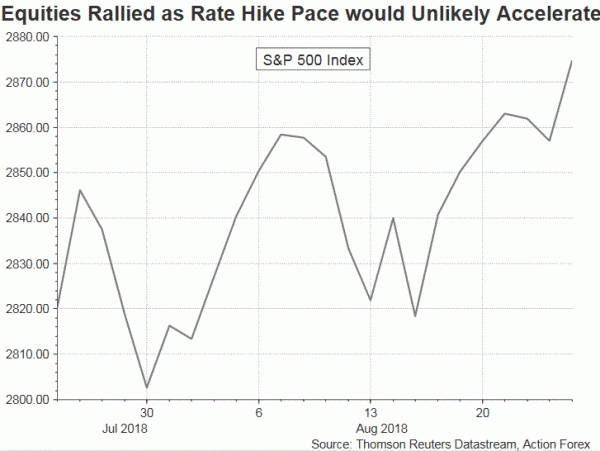Weaker USD, lower Treasury yields, higher equities… Market reactions showed that Fed’s chair Jerome Powell’s speech at Jackson Hole symposium was interpreted as “dovish”.
Discussing about “Monetary Policy in a Changing Economy”, Powell revealed the challenges of navigating the stars – u*, the natural rate of unemployment, r*, the neutral real rate of interest, and Π*, the inflation objective, in setting monetary policies.
Emphasizing uncertainty is nothing new. Yet, Powell’s elaborations on Greenspan’s “wait and see approach” and the Brainard’s conservative principle when facing uncertainty have likely sent a dovish message to the market.
All in all, the speech does not alter our view that a rate hike in September in anchored, which is followed by another in December. What the market is closely watching now is whether the Fed would trim one rate hike next year, depending on the upcoming data.
Powell suggested that assessing “stars” (the natural rate of unemployment, the neutral real rate of interest and the inflation target) is challenging in recent years as the “best assessments of the location of the stars have been changing significantly” after the global financial crisis.
The Fed has implemented unprecedented measures (QE) to stimulate growth and inflation in the aftermath of the 2007/08 crisis. Powell revealed that as normalization proceeds, both the Fed members and external analysts have regularly adjusted their assessments of the stars. Given the uncertain economic outlook, the Fed has been navigating the stars in “hazy view” in order to balance between two risks: moving too fast and needlessly shortening the expansion, versus moving too slowly and risking a destabilizing overheating.
In light of the uncertainties, Powell discussed approaches of former Fed Chairman Alan Greenspan and economist Willian Brainard. For the former, Powell recalled in mid- 1996 that Greenspan had a “hunch” that the US was experiencing the wonders of a “new economy” in which improved productivity growth would allow faster output growth and lower unemployment, without serious inflation risks. As such, Greenspan opted to pause rate hikes. Powell suggested that Greenspan’s pause had lifted economic growth.
Concerning the latter, Brainard’s principle suggests that policy should exhibit conservatism in the face of uncertainty. Powell’s elaboration on Greenspan and Brainard’s approaches suggest that he favors a cautious and gradual approach to the Fed’s monetary policy.


 Signal2forex.com - Best Forex robots and signals
Signal2forex.com - Best Forex robots and signals




